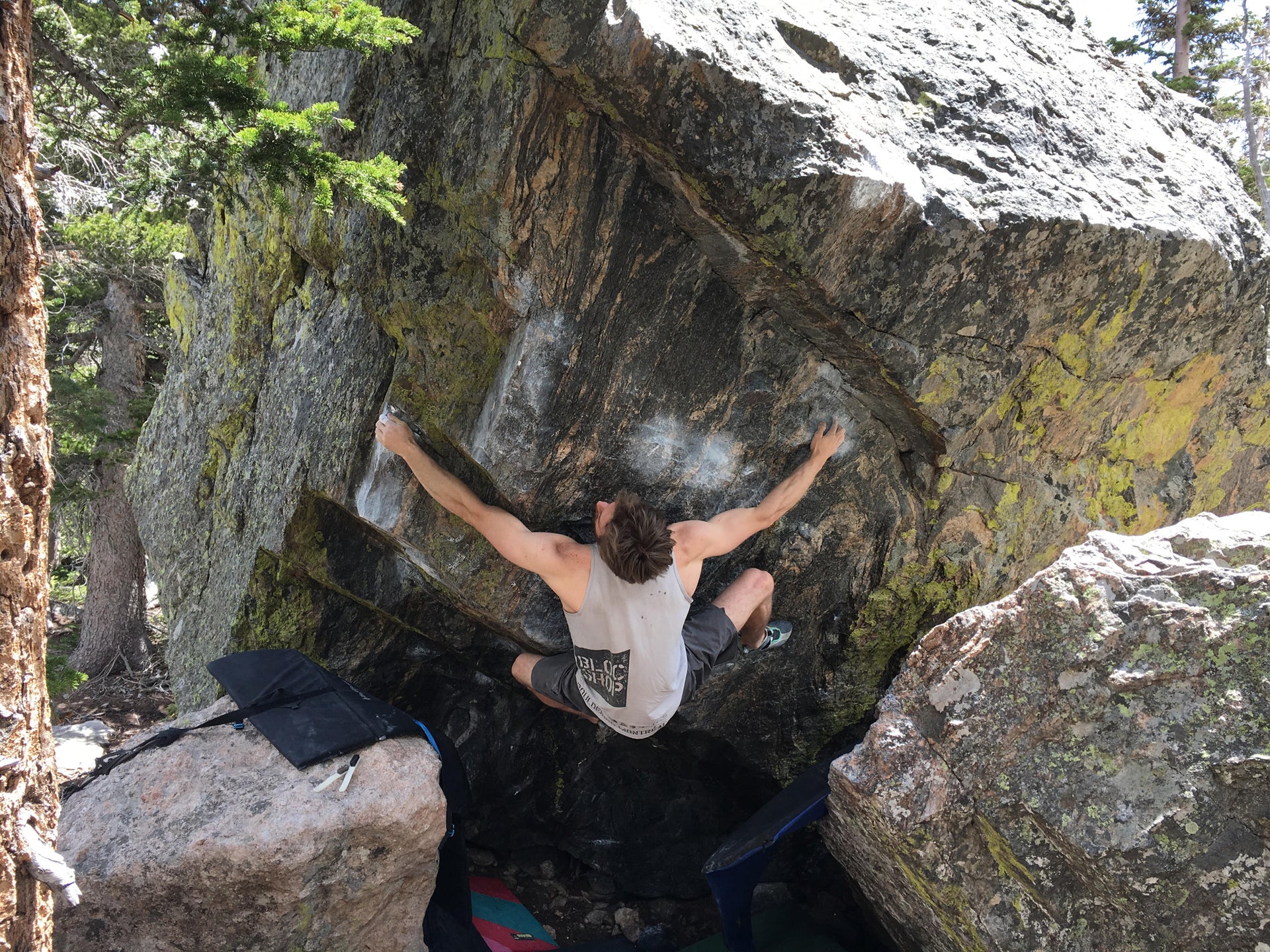
Staying Strong Through a Finger Injury | Matt Fultz
Sending Storm Shadow Low (V12) just 7 weeks post finger injury.
So, you just got a finger injury? That sucks. No really, I feel for you. I've had 2 finger injuries in the past 2 years, and I totally understand. There can be some low moments. It is devastating when you are suddenly unable to do one of your favorite activities. However, through my injury experience, I've discovered some workouts that have kept me motivated and inspired in what would otherwise be a pretty crappy time.
Although I had two similar finger injuries, I handled them in very different ways. My first injury I believe I handled poorly which lead to prolonged pain and frustration. I returned to climbing too quickly and did workouts I was not ready for. The most recent injury I had a smart therapy plan that I stuck with, and a workout schedule that was easy on my finger, which leads to quick recovery and even added fitness upon my return to climbing.
Below are a few tips and tricks I learned along the way which have helped me tremendously. However, I can't stress enough that I am not a physician and I would one-hundred-percent recommend seeing a specialist (preferably a physical therapist that is also a climber) to find a program that is just right for you.
Will Anglin (of Tension Climbing) has been an excellent mentor to me and has been valuable in my recovery process. Most of these tips and workouts come from him. Will says "It's important to increase blood flow to the injured finger and stress the body metabolically, but with a low mechanical load on the finger." These tips and lifts incorporate that strategy.
Here are a few general tips and a lifting guide before I get into a sample workout and recovery schedule.
1. Resist the temptation to test your finger
Especially in the first couple of weeks after your injury, it can be tempting to try to hang or crimp to test your finger. Trust me, your finger is still injured, so just don't. You could potentially add weeks to the healing process by repeatedly testing and re-injuring your finger in these crucial initial weeks. So stop climbing! I know it sucks, but you have to get over it. Will says, "It's tough, but you have to be patient. It's not worth it to blow all your hard work."
2. Don't push it
Be careful if it is uncomfortable. I know it sounds simple, but do what you can and don't do what you can't. You'll thank yourself later.
3. Stay active
Just because you hurt a finger doesn't mean you have an excuse to lay around all day. Continue to run, bike, swim and find general strength training/activities you enjoy and can do safely.
4. Lift
Below are just a few lifts suggested to me by Will. I found these to be very helpful and allowed me to stay in shape when climbing wasn't an option. Make sure your form is excellent. If you are unsure about form please consult a trainer.
Will says "The most important lifts for climbers have you pulling down, pulling in, pushing up, and pushing out. But avoid any lift that provokes pain in the finger.
Try to find workarounds when you can. For example, if just hanging onto a bar hurts, try to find a thicker bar."
Try to make time to do these lifts 2-3 times per week. If you stay focused, these shouldn't take more than 30 minutes to complete in total. Also, feel free to add in additional exercises if prescribed by your therapist or trainer.
Starting Lift 1: Single Arm Dumbbell Chest Press
Start out with a weight you can barely lift 10 times. Switch arms. Complete 5 sets with full recovery between sets. Eventually, you will increase the weight and decrease the reps (more info below).


Starting Lift 2: Single Arm Overhead Dumbbell Press
Start out with a weight you can barely lift 10 times. Switch arms. Complete 5 sets with full recovery between sets. Eventually, you will increase the weight and decrease the reps (more info below).


Starting Lift 3: Assisted Single-Arm Pull-Ups
Using sturdy resistance bands to assist you, do 5 single-arm pull-ups. Switch arms. Complete 3 sets with full recovery between sets. Eventually, you will decrease the resistance bands (more info below).
If assisted single-arm pull-ups are too difficult, then regular/weighted pull-ups will do just fine.


Starting Lift 4: Single-Leg "Pistol" Squats
Start out with a dumbbell you can barely lift 5 times. Switch legs. Complete 3 sets with full recovery between sets. To increase the difficulty further, do these while standing on a balance board (when I do this, I don't even need to add a dumbbell). Eventually, you will increase the weight and decrease the reps (more info below).


Sample Weeks 1-2:
No climbing. Halt any activity until you are able to see a specialist as soon as possible to assess the severity of the injury.
The first two weeks are crucial, as the joint is extremely fragile. I straight-tape my finger with KT tape during exercise and when I sleep to avoid accidental bending.
If you are cleared to hang on a bar/rings and it is comfortable, consider doing some of the exercises described above in addition to your PT (again, please consult your physical therapist to make sure you're cleared to do these and consult your trainer to be sure you are using excellent form!):
Sample Weeks 2-4:
If after no less than 2 weeks your finger is feeling better (and the swelling has gone down substantially) then you might be able to reintroduce some extremely light and easy climbing into the mix. I suggest investing in a metal finger splint to completely immobilize the injured finger. If your injury is on your pinkie or index, then you're pretty lucky as it won't hinder your climbing as much (you can climb front/back 3 without it being too awkward). However, if your middle or ring is injured then climbing will take some adjustment and the holds you grab with that hand should be very ergonomic.
Add just 30-40 minutes of easy climbing (basically just a warm-up) to your lifting and PT for the next two weeks.
Sample Weeks 4-6:
Here is where things can get a little tricky. If things are going well and you are confident, then take that metal splint off and immobilize the finger with tape before you climb. You want to keep the intensity and duration of climbing about the same, but reintroduce that finger to gripping holds in an open handed position.
Maintain climbing intensity and duration, using your finger just a bit more. Continue with your lifting and PT.
Sample Weeks 6-10:
Try X-taping or H-taping. Gradually increase climbing intensity and duration until you add 20-30 minutes to your sessions (about 1 hour total).
In addition to increased climbing duration and intensity, try adding 5-10 pounds to each lift, and decrease the reps by 2-3 per set.
Sample Weeks 10-12:
If you feel ready, try climbing with no tape. Gradually increase your climbing intensity and duration at your comfort level.
Try adding 5-10 pounds to each lift, and decrease the reps by 2-3.
Sample Weeks 12+
After you are able to climb pain-free for 2 weeks, then you are on your own! Remember to be gradual when introducing new moves, holds, and workouts.
That's all I have for you. Good luck on your journey back to full health. Be safe, have fun, and get strong!

Competing at the Vail World Cup just 9 weeks post-finger injury.
